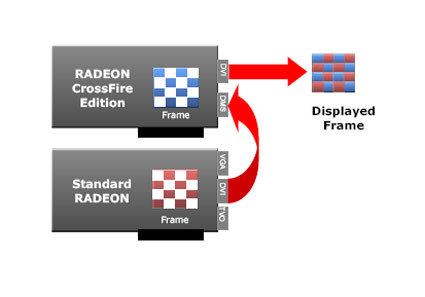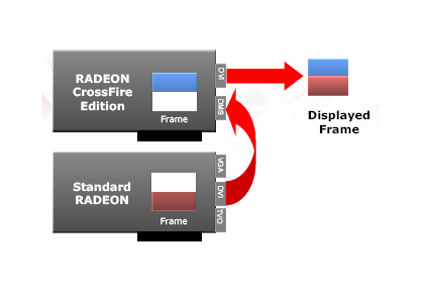NVIDIA Is In The CrossFire
Image Rendering Modes
Let's take a look at the technology, explaining how CrossFire renders information into an image on the screen. With CrossFire there are three performance modes that the cards can use to work together: SuperTiling, Scissor, and Alternative Frame Rendering.
SuperTiling Mode
In this method, the frame is broken up into 32 by 32 pixel "quads," or in layman's English, blocks. In total, the checker board has 256 sections. The odd numbered quads are computed by one card, and the even quads by the other.
The benefit here is that all applications and games can be rendered using this method. ATI has enabled this as the default method for all D3D games. Still, with all improvements, there is always a new negative. The detriment here is that, although they are only displaying half of the image, each card still has to compute all of the geometry of the scene. This makes the performance increase logarithmic and not exponential. However, even with this penalty, current and future titles that are pixel shader intensive will benefit from this mode, and the more a game requires the shaders, the more substantial are the gains that CrossFire will provide.
Scissor Mode
This mode is nothing new, since we have seen it in NVIDIA's SLI. Here, the top half of the screen is rendered by one card, and the second is rendered by the other card. With the SLI method, the user can choose to have only that which is above the horizon in a game rendered by one card and the bottom half under the horizon rendered by the second. But unlike NVIDIA's solution, the ATI percentages are fixed.
Although there is less flexibility in this option than NVIDIA's solution, ATI feels that the sharing of the workload should be equalized in order to get the most out of both cards. Dynamic load balancing between the cards forces the two percentages to remain as equal as possible. The benefit of Scissor Mode is that it will work with any game, D3D or OpenGL; the drawback is the same as with the SuperTiling Mode: each card has to do all of the geometry work for each scene.
Get Tom's Hardware's best news and in-depth reviews, straight to your inbox.
Current page: Image Rendering Modes
Prev Page Advantages Of CrossFire Over SLI Next Page Alternative Frame Rendering (AFR) Mode
